






introduced by
CHARLES FORD athene pallas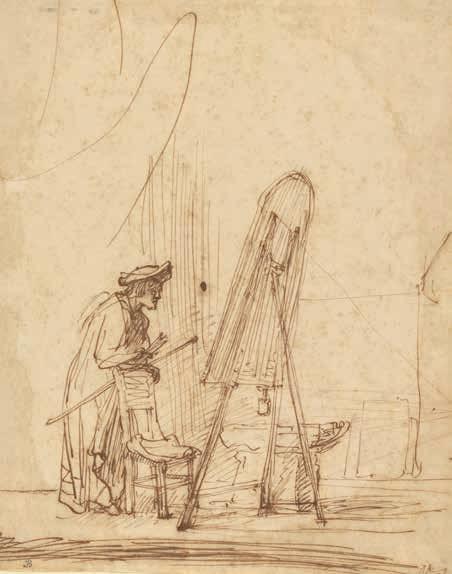

Introduction by CHARLES FORD
p. 7
Life of Rembrandt, 1675
p. 37
Life of Rembrandt, 1686
p. 49
Life of Rembrandt, 1718
p. 63
List of illustrations
p. 110
Opposite: An artist in his studio, 1630
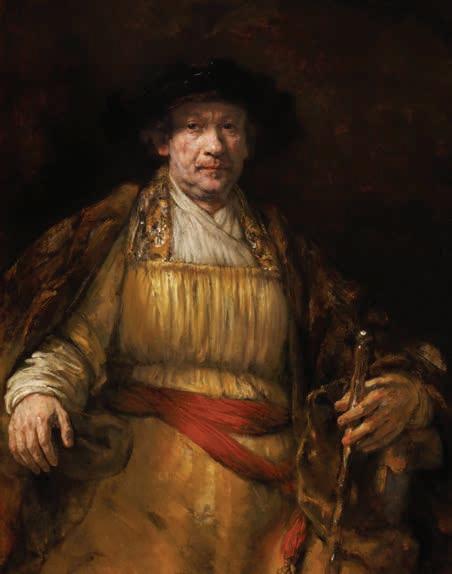

Rembrandt was quite possibly the most talked-about artist of his time – and just possibly of any time. These three biographies, published between five and fifty years after his death, and based in part on personal recollections, vividly attest the fascination of his art for contemporaries. But it may surprise us to find that this was a horrified fascination. If Rembrandt is today for many people a touchstone of artistic endeavour, for these early critics it turns out to be a touchstone of what art should not be.
Sandrart, Baldinucci and Houbraken, German, Italian and Dutch respectively, represent a broad swathe of opinion. Joachim von Sandrart (1606-1688) was a muchtravelled Nuremberg painter. He visited the Netherlands in the 1640s, where he met Rembrandt, then at the height of his fame. Sandrart painted a group portrait which hung beside Rembrandt’s Night Watch in the Kloveniersdoelen Militia Hall – the paintings still hang together in Amsterdam’s Rijksmuseum. Although celebrated as a
Opposite: Self-portrait, 1658
charles ford
painter during his lifetime he is now best known as the author of the Teutsche Academie (‘The German Academy’, 165). This is a lengthy and compendious work, covering art and architectural theory as well as artistic biography. His literary ambition is evidenced by the appearance of a Latin edition of this work in 1683. Filippo Baldinucci (1624-16) was also an artist, but he too is now best known as a writer. Born in Florence, he worked for the Medici family cataloguing their collections of drawings and paintings, and he remains an important figure in the history of connoisseurship. He wrote a biographical dictionary of artists, as well as shorter works such as the Cominciamento, e progresso dell’arte d’intagliare… (‘Origins and development of the art of engraving…’, 1686) in which we find his account of Rembrandt. He had no direct knowledge of Rembrandt except, as he records, through knowing a former pupil living in Rome. Arnold Houbraken (1660-11) was born in Dordrecht and worked as a painter and printmaker; he also is now best known as a writer. De groote Schouburgh der Nederlantsche Konstschilders en Schilderessen (‘The great Theatre of Dutch Painters and Painteresses’, 118-21) is an important source on Dutch painters of the 1th century, with much of the information obtained from living relatives and pupils of the old masters. Houbraken had been trained by Samuel van Hoogstraten, who had been a pupil of Rembrandt.
When we read the biographies it becomes immediately apparent that all three writers disapproved of Rembrandt, which begs the question: why did they chose to write about him? The reason is that, for critics of their generation, grounded in the newly invigorated classicism of the second half of the seventeenth century, Rembrandt (for all the appeal of his works, and perhaps because of the appeal of his works) represented a threat. These critics tell us about Rembrandt to warn us about Rembrandt.
‘Classicism’ was gaining ground during the period – especially in the newly founded Academies, where it was becoming increasingly formalised as a system. Giovanni Pietro Bellori, friend and ally of Poussin and the voice of the French Academy in Rome, was a key figure. He wrote an important history of Renaissance art, Le Vite de’ pittori, scultori et architetti moderni (‘The Lives of Modern Painters, Sculptors and Architects’, 162). In it he described how the whole Renaissance had entered a crisis during the later sixteenth century, which he explained as the simultaneous emergence of ‘mannerism’ and ‘naturalism’. Mannerism Bellori defined as an art about art, divorced from the study of nature; naturalism was the over-zealous attention to nature, what he described as mere slavish imitation. Bellori argued that artists should synthesise art and nature. This synthesis should occur during the practice of drawing (in Italian:
disegno). During the preparation of their works artists must select from and then adapt nature according to an Idea. The capacity to use the Idea came in part from talent, and in part it was acquired. In order to be able to recognise the Idea, young artists should be taught the canon of great works of art; they should draw after good examples. As is the way with classicisms, this was not proposed as an innovation, but as a return to first principles, to the practice of Raphael and, before him, to that of antiquity.
Rembrandt’s paintings fell short of this academic vision of art. Houbraken readily admitted that Rembrandt had a genius for drawing and painting from life, but lamented that his talent was intuitive and hardly an instructive example for young artists. For the classical critic Rembrandt’s pictures did not represent the Idea. They judged his nudes and saw that he did not make judicious selections from nature; that is, his selection was not guided by a knowledge of classical art. Neither his paintings nor his prints made conventional, definitional use of line. His drawings did not represent the painstaking processes of composition. Although he sometimes used sketches, he never used preparatory cartoons and seems to have composed his pictures in paint on the
Opposite: Sarah awaiting Tobit (Hendrickje Stoffels?), c. 1649
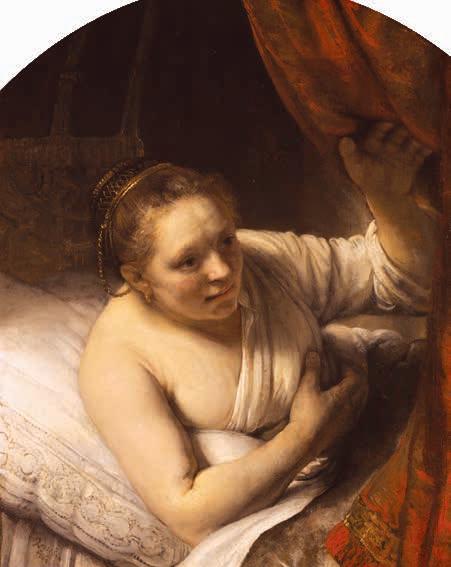
canvas or panel. Baldinucci also lamented Rembrandt’s ignorance of perspective.
All these features of a properly classical painting constituted the science of art. Rembrandt’s ability to prepare and handle paint merely evidenced his command of the craft of painting. Rembrandt was therefore perceived to be failing to rise to the proper level of professional competence required for a modern artist.
Sandrart, Baldinucci and Houbraken did not agree exactly on why Rembrandt failed, but their different explanations overlap. For example, they all agreed that Rembrandt claimed ‘Nature’ as his model rather than relying on the rules of art. In Bellori’s history of art Caravaggio was a notorious and exemplary naturalist, and his biography of Caravaggio opens with a reference to the classical author Pliny, who had described a Greek sculptor called Demetrios in much the same terms. In a similar vein Houbraken interrupts his account of Rembrandt to quote Van Mander’s account of Caravaggio. For these writers biography was a vehicle for philosophical reflection rather than a documented account of the life of an individual; we ‘get the picture’ by recognising prototypes. Because it was obvious to classical critics that Rembrandt did not work within the rules and procedures of art, it followed that he must be linked with Caravaggio the arch-naturalist. Caravaggio had been
demonised by Bellori as an enemy of art and Caravaggio’s supposed denial of the rules of art was explained as the consequence of Lucifer-like pride. A whiff of sulphur accompanies similar references to Rembrandt’s arrogant preference for his own experience of nature over the claims of the rules of art in all three biographies. For Renaissance critics the relationship between an artist and his works was summed up in the proverb ‘every painter paints himself’. To understand the art object was to understand of the character of the artist (and vice versa). This is why biography plays such an important role in histories of art of the period. For Sandrart, Rembrandt was a badly educated plebeian and knew no better. Baldinucci said much the same, but he described a more complex web of factors, for example Rembrandt’s bizarre religious beliefs. Baldinucci also associated Rembrandt’s bad art with his (supposedly) ugly, plebeian body. For Baldinucci, Rembrandt was the vulgar, extravagant beneficiary of the ignorance of his patrons; that Rembrandt succeeded in the money-city of Amsterdam explains why he was so over-esteemed (here we can read an antipathy for the mercantile, Protestant north). Houbraken was gentler with Rembrandt, but could not, in the context of his general thesis, tolerate
Overleaf: Paired portraits of a man and a woman, c. 1658-60




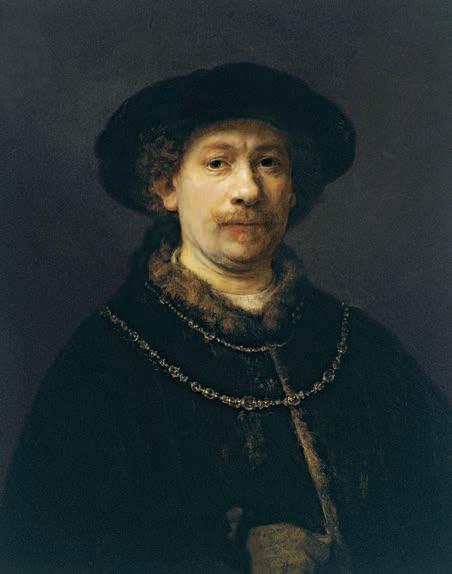

him. For Houbraken, Rembrandt’s rejection of external authority, his love of money, even his homeliness, all indicate classicism’s ‘other’: the self-made, self-validating, craft-based painter for profit. It is Houbraken who tells the story of Rembrandt’s dead monkey, commemorated in a painting against the sitter’s wishes. We should read this as an allegory. The painting may well have existed, but need not have. In the Renaissance, the monkey was a ubiquitous emblem of slavish imitation and in the context of the biography the symbolism is compelling. This symbolism takes on a special resonance when we are told that the painting of the monkey was eventually used as a partition between two student workrooms. Through these oblique references to prototypes, types and motifs the reader is edged towards a particular understanding of Rembrandt.
It would be a mistake, therefore, to read these texts as straightforward accounts of the historical Rembrandt. He is ‘constructed’ as the anti-classical painter; that is his role in the histories being told. We might contrast this figure with Rembrandt’s own ‘self-image’ in the selfportraits. Here we are presented with a number of types, one of the most familiar being the majestic figure in historical robes wearing a gold chain, the very type of the
Opposite: Self-portrait with beret and two gold chains, 1642-43
Renaissance courtier, derived from aristocratic portraiture. This would seem at least to challenge the idea that Rembrandt was quite as vulgar or ignorant of the history of art as was claimed by his classical critics. The golden age of author-centred criticism came in the nineteenth and early twentieth centuries. In the generations following Romanticism these ‘classicist’ biographies were read with the value judgements inverted. They were reinterpreted as evidence of Rembrandt’s honesty, of his bohemian free spirit. But those readings were still no more than caricatures, albeit approving ones. A popular image emerged of Rembrandt as an earthy, natural genius misunderstood by his contemporaries; this is what we are shown in Charles Laughton’s portrayal of Rembrandt in Alexander Korda’s film. In the last twenty-five years art historians have retreated from such positions, and a modern student will be confronted with competing notions of ‘historical agency’ at work within ‘discourses, ‘culture’, or simply ‘contexts’.
Houbraken’s account of Rembrandt’s youth and training accords with our own best knowledge. Trained locally in Leiden, he went to Amsterdam, where he studied
Opposite: Self-portrait, 1659. This is based on Raphael’s portrait of Baldassare Castiglione (author of The Courtier), which Rembrandt had seen when it was sold at auction in Amsterdam in 1639


briefly with Pieter Lastman, an artist who worked in what then would have stood out as a ‘classical’ manner. Lastman produced small-scale narrative pictures, full of accurate archaeological detail, in juicy, brightly-coloured paint. Lastman was expert in capturing the drama and emotional intensity of the situations he depicted and his compositional formulæ, figural types and subject matters made a enormous impression on the young painter who frequently reworked them. Rembrandt returned to Leiden where he shared a workshop with another young painter, Jan Lievens. He also took on his first pupil, Gerrit Dou. The work of Lievens, Dou and Rembrandt from the period 162-30 has often been confused, and attribution and re-attribution are likely to go on. Indeed, as Rembrandt worked in close proximity to others all his life, there is always a problem attributing any individual work absolutely to him at any time during his career. As well as painting, both Rembrandt and Lievens experimented with etching at this time.
In about 1630 Rembrandt moved to Amsterdam. His arrival was marked by a major portrait commission –The Anatomy Lesson of Dr Nicolaes Tulp (Mauritshuis, The Hague). Rembrandt’s move was enabled by his business
Opposite: Anna accused by Tobit of stealing the kid, 1626
Overleaf: The Anatomy Lesson of Dr Nicolaes Tulp, 1632
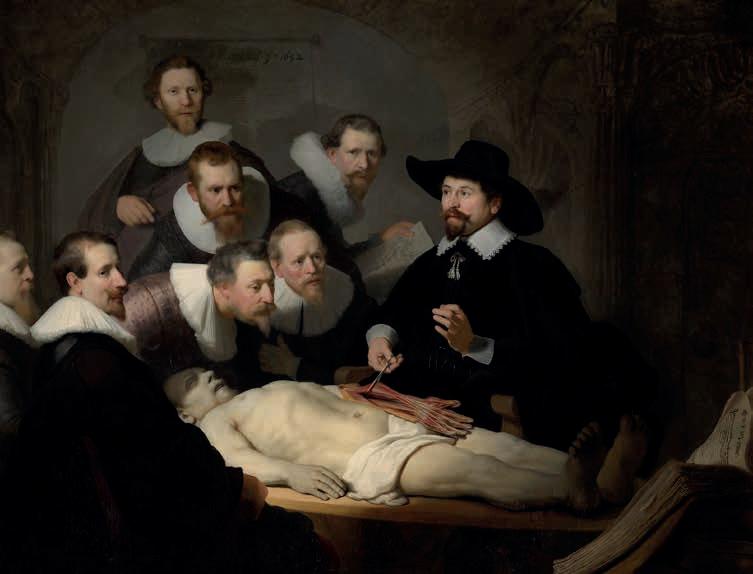

charles ford
relationship with an important Amsterdam art dealer, Hendrick Uylenburgh, whose niece Saskia he would later marry. He was immediately successful in Amsterdam. He painted a series of portrait commissions remarkable for their combination of tight, highly finished detail and delightfully inventive compositional formulæ. He also produced numerous subject pictures, some even for the court at The Hague, and initiated his famous studio full of students. Within a decade he was rich and famous – a fame amplified by the success of his prints, which circulated throughout Europe.
Rembrandt’s career might be thought of as having reached a high point in 1642 with the painting of The Company of Frans Banning Cock (also called The Night Watch; Rijksmuseum, Amsterdam, ill. pp. 52-53). As Baldinucci reports, The Night Watch was well received (although Rembrandt wasn’t paid quite as much for it as Baldinucci suggests, but then Baldinucci was playing on the legendary wealth of Amsterdam). But high point or not, it is clear that Rembrandt continued to obtain prestigious commissions and attract students long after 1642 (Bernhard Kiel, Baldinucci’s source of information on Rembrandt, studied and worked with him between 1648 and 1656). In 1656 Rembrandt began the process
Opposite: Samson threatening his father-in-law, 1635

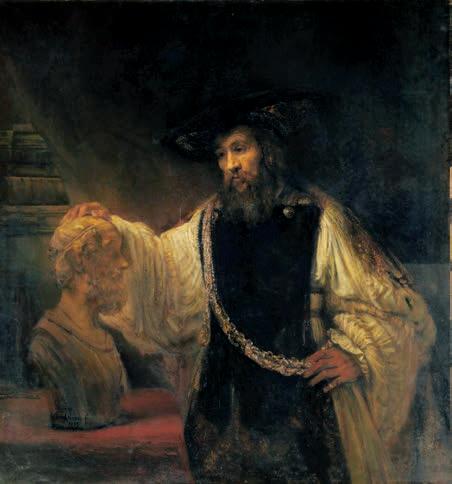

of bankruptcy. Even though his income declined he continued to live well, and what is more, he continued to live in his large house (now the Rembrandthuis Museum) until after 1660. At about this time the celebrity of his prints drew him to the attention of a certain Don Ruffo, a Sicilian nobleman living in Messina, and Rembrandt was commissioned to paint the Aristotle Contemplating the Bust of Homer (Metropolitan Museum, New York) and a ‘portrait’ of Homer (Metropolitan Museum, New York, ill. p. 100). Long after his bankruptcy he still painted works for public spaces – in 1662 he produced an important group portrait, The Syndics of the Drapers’ Guild (Rijksmuseum, Amsterdam). Compared to most of his contemporaries Rembrandt had a long and successful career. In his prime he must have cut a figure in the salesrooms as he put together a remarkable collection of art and curiosities, which we can admire from the inventory produced at his bankruptcy. He remained a friend of influential people throughout his life.
In 1648, some years after Saskia’s death in 1642, Hendrickje Stoffels moved in. She and Rembrandt did not marry, despite criticism from the elders of her church; it would seem that this was so that he could retain a legacy
Opposite: Aristotle contemplating the bust of Homer, 1653
Overleaf: The Syndics of the Drapers’ Guild, 1662


from Saskia’s family. He held onto his earnings after his bankruptcy by dealing through Hendrickje and his son, Titus. Throughout his life he was notorious for delaying the delivery of works and we have a fair correspondence relating to that. We also have evidence that his workshop was enormously productive (there are far ‘too many’ Rembrandts) and we must conclude that, until the end of his career, demand for his paintings tended to outstrip supply. There are fewer paintings (and only two etchings) from the 1660s when, having moved house, he no longer ran his huge studio. And Rembrandt’s success did not cease with his death. There is no reason to doubt Houbraken when he speaks of the enduring popularity of Rembrandt’s works, and enough forgeries of his works in all media exist from all periods to suggest that he remained a favourite in the auction house.
Only Baldinucci wrote of Rembrandt’s bankruptcy. News of this failed to reach Houbraken – or maybe the Dutch author chose to suppress it out of that sense of decorum he commends to the artist drawing from nature. Rembrandt’s financial dealings, as they have been revealed in recent documentary histories, are rather sordid. His bankruptcy was stretched out over several years and no doubt hurt others as much as him. When
Opposite: Hendrickje Stoffels, c. 1654

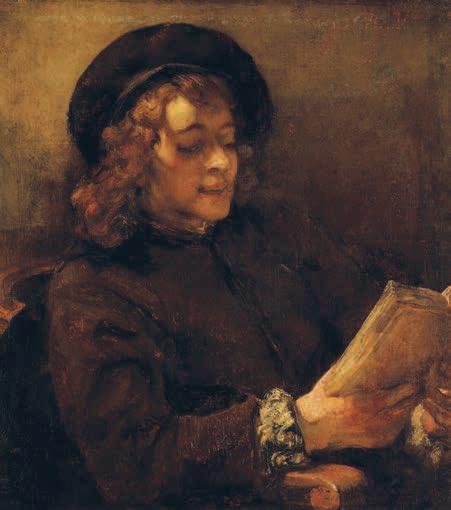

his son Titus married it was into another branch of the Uylenburgh family, effectively settling the outstanding problem of Saskia’s legacy. Just how different that makes Rembrandt from any other middle-class Amsterdammer is hard to say. Hundreds of people went bankrupt every year in seventeenth-century Amsterdam.
Documentary history relies upon court records, evidences of disputes, the transcripts of errors and disasters, and the most visible people in history tend to be the most litigious. Rembrandt is certainly visible in such histories. So we can conclude that Rembrandt was just that much more successful, and that much more accidentprone, than the average. What we do not need is the pious moralising offered by his three early biographers –no more than we need to sentimentalise him as a victim of an uncomprehending and uncaring world. Rembrandt died in relative obscurity but he did not die alone, and his circumstances were much less miserable than average. True, Titus, his son, had died a few months earlier, but he had left a baby daughter, Titia. Cornelia, Rembrandt’s daughter by Hendrickje Stoffels, was still in Amsterdam; she did not leave for Batavia, in the Dutch East Indies, with her new husband until the year after her father died. Like most seventeenth-century
Opposite: Titus reading, 1656
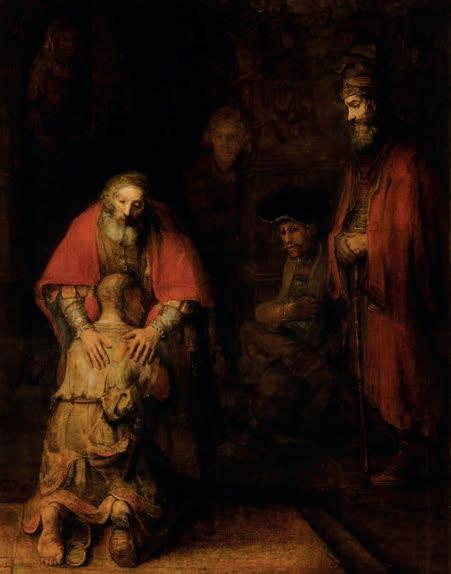

painters, many of them also very successful, Rembrandt was buried in an unmarked grave. His lasting memorial is a collection of paintings, drawings and prints and a widely dispersed paper trail of documents. The works and the documents have been put together in different ways over the years to produce markedly different pictures. At the moment a very purist scholarship has limited his paintings to a mere 350 or so; time was that he was author of over 1000 paintings.
We get the ‘Rembrandt’ we deserve. The following biographies show how this astonishing man, the most discussed painter of his generation, continued to function within a succeeding generation’s debates about the very value of art. Indeed, it is clear that what was at stake were the values of civilisation itself. Remarkably, Rembrandt and his performance of the art of painting continues to feature in such debates right down to our own day. This is why these historical texts deserve sympathetic – and critical – reading and re-reading.
Opposite: The Return of the Prodigal Son, 1669
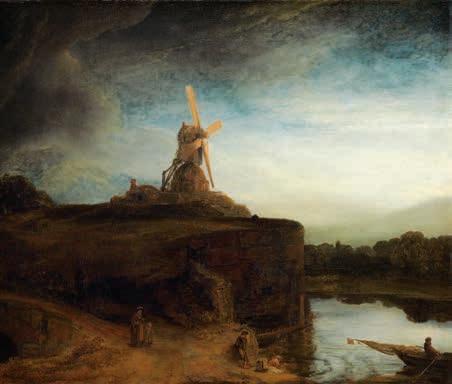
The Mill, 1645-48

Teutsche Academie
1675


It is almost to be wondered at that, being merely someone sprung up from the flatland and but the son of a miller, the excellent Rembrandt von Rijn [sic] was driven by nature towards noble art, and that it should happen in such a way that he achieved such a high eminence in it – which he gained through immense hard work, his innate predilection and natural talent. He started in Amsterdam under the celebrated Lastman, and, thanks to his inherent gifts, unsparing industry and continuous practice, he lacked for nothing – except that he had not visited Italy and other places where he might have studied the Antique and the theory of art. This was a defect all the more serious since he only read Netherlandish poorly, and therefore gained little from reading. Consequently he stuck with his own manner of painting, and did not hesitate to oppose and contradict our rules of art such as anatomy and the proportions of the human body, perspective and the usefulness of classical statues, Raphael’s drawing and well-judged composition, and the academies which are so particularly necessary for our profession. In making this choice he argued that one should be guided by Nature alone, and by no other rules. As a result he approved
Opposite: Self-portrait, c. 1628